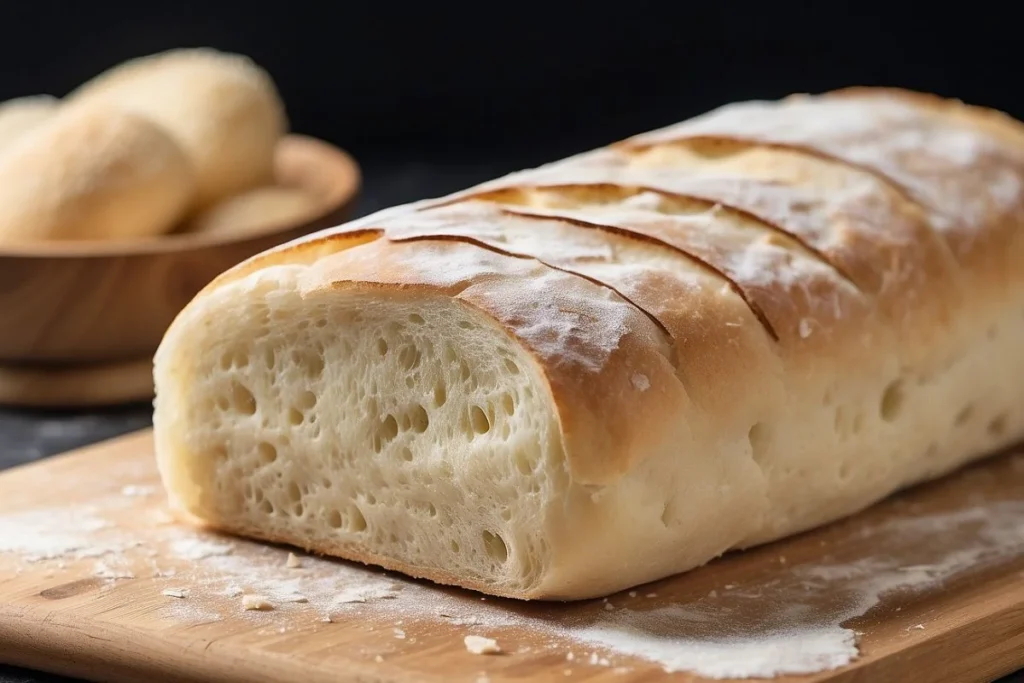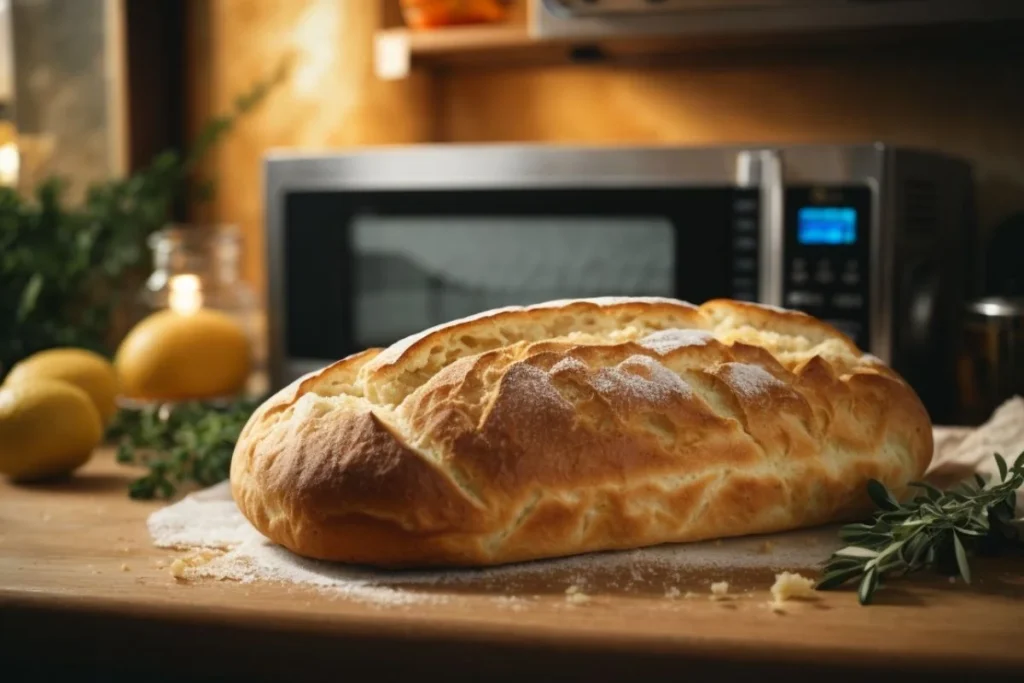
Can You Defrost Ciabatta in the Microwave | Ultimate Guide
Craving a warm and fresh ciabatta but don’t want to wait hours for it to thaw? Look no further! In this guide, we’ll show you how to defrost ciabatta safely in the microwave, saving you time and satisfying your taste buds in no time.
Defrosting frozen ciabatta bread can be tricky—it might turn dry and lose its delicious taste and texture. But no worries! With our tips and tricks, you can enjoy perfectly thawed ciabatta that tastes like it just came out of the oven.
Using the microwave for defrosting is convenient, but you need to follow specific steps for the best results. We’ll walk you through the whole process, from choosing the right microwave setting to preserving the ciabatta’s quality and freshness.
Whether you’re making a tasty sandwich or serving side bread for a family dinner, our guide ensures your ciabatta is defrosted perfectly every time. Let’s get into it and learn how to safely defrost ciabatta in the microwave.
Table of Contents
ToggleWhy Defrosting Ciabatta in the Microwave is a Convenient Option
Defrosting Ciabatta in the microwave is a super handy trick for anyone who wants a quick and easy way to enjoy this tasty Italian bread. The microwave heats things up fast, so you can defrost your ciabatta in a flash. This is perfect for folks with busy lives or those sudden cravings.
Unlike the old-school methods that take forever, the microwave gets the job done quickly without messing up how the ciabatta feels or tastes. The bursts of energy it gives off get right into the bread, thawing it out without making it weird.
This method is especially great for those times when you forgot to plan ahead or need a last-minute fix for a meal.
Moreover – the microwave isn’t just for defrosting. You can also play around with how soft or crispy you want your ciabatta. Keep an eye on it, and you’ll nail the perfect balance to suit your taste

The Risks and Challenges of Defrosting Ciabatta Incorrectly
Defrosting ciabatta in the microwave is a convenient way to do it, but it comes with its own set of risks and challenges, like any cooking method. Understanding and dealing with these potential issues is important to make sure your ciabatta turns out as good as possible.
One big risk is uneven thawing. The microwave uses heat to thaw, and if you’re not careful, parts of the ciabatta might thaw faster than others. This can make the loaf have different textures, with some parts being too soft and others still frozen.
Another challenge is overdoing it in the microwave. If you expose the ciabatta to too much heat for too long, it can end up dry and rubbery. It’s important to find the right balance between thawing and keeping the original quality, so you need to watch it closely throughout the process.
Condensation is also common when thawing in the microwave. The heat can create moisture, making the ciabatta soggy. To avoid this, use absorbent materials and make sure the container you’re using in the microwave allows for proper ventilation.
Picking the wrong power settings or not following the manufacturer’s guidelines on storage and thawing can mess up the final product. If your ciabatta has extra ingredients like fillings or toppings, you might need to consider specific things to keep the taste and quality right.
Lastly, it’s not a good idea to try to refreeze ciabatta after thawing it incorrectly. This can make the bread’s texture and flavor even worse, and it won’t be as good overall.

How to Defrost Ciabatta in the Microwave | Step-by-Step
Microwaving ciabatta to perfection requires a thoughtful and systematic approach. Follow this step-by-step guide to ensure that your bread emerges from the microwave as delicious and satisfying as ever.
- Step 1: Preparation: Begin by taking the ciabatta out of the freezer and removing any packaging. Ensure that the bread is separated or sliced if needed, allowing the microwave’s energy to penetrate evenly during the defrosting process. Place the ciabatta on a microwave-safe plate, readying it for the next steps.
- Step 2: Power Setting: Most microwaves offer a defrost setting, specifically designed to gently thaw frozen items. If your microwave has this feature, select it for optimal results. If not, choose a low to medium power setting, typically around 30-50% power. The goal is to defrost the ciabatta gradually, preventing any undesirable changes in texture.
- Step 3: Time Adjustment: Microwaves vary in power, so it’s crucial to adjust the defrosting time accordingly. Start with a conservative estimate, such as 1-2 minutes for smaller portions or slices. It’s better to check the progress periodically and add more time if needed than risk overheating and compromising the ciabatta’s quality.
- Step 4: Covering the Ciabatta: To retain moisture and prevent the bread from drying out during the defrosting process, cover the ciabatta loosely with a damp paper towel or microwave-safe plastic wrap. This step is particularly important for larger loaves, ensuring that the outer layers don’t become overly dry before the center has thawed.
- Step 5: Flipping and Rotating: For even defrosting, flip and rotate the ciabatta halfway through the process. This helps distribute the microwave’s energy evenly, preventing one side from becoming too warm while the other remains frozen. It’s a simple but effective technique to ensure a consistently thawed loaf.
- Step 6: Monitoring Texture: As the ciabatta begins to thaw, keep a close eye on its texture. The goal is to achieve a soft and pliable consistency without any hot spots or areas that remain frozen. Adjust the power setting and time as needed to achieve the desired results.
- Step 7: Customizing Texture: One of the advantages of using the microwave for ciabatta defrosting is the ability to customize the bread’s texture. If you prefer a softer consistency, reduce the defrosting time slightly, while a crispier result may require a bit more time in the microwave. Experiment with these variables to tailor the ciabatta to your personal preferences.
- Step 8: Final Check: Once the ciabatta is adequately thawed, give it a final check to ensure the entire loaf or slices have reached the desired consistency. If there are any areas that still feel frozen, apply a short burst of additional defrosting time.

Alternative Methods for Defrosting Ciabatta Bread
While microwaving proves to be a quick and convenient method for defrosting ciabatta, alternative approaches offer diverse options catering to different preferences and circumstances.
- Defrosting at Room Temperature: If you’ve got time on your side and want to keep your ciabatta in top shape, try defrosting at room temperature. Just place the frozen bread on a clean surface or in a shallow dish. Cover it loosely with a cloth or plastic wrap to prevent anything unwanted from getting in. It takes longer than some methods, but your ciabatta will thaw evenly, keeping its original texture and flavor.
- Oven Defrosting: For a faster option, use the oven. Preheat it to around 300°F (150°C), then put the frozen ciabatta on a baking sheet, making sure there’s space around each piece. This method is a good compromise between speed and quality. The gentle heat speeds up the thaw without sacrificing the bread’s goodness. Just keep an eye on it to make sure it doesn’t get weird textures.
- Refrigerator: The fridge is another option for a slow and controlled thaw. Leave the ciabatta in there overnight for a gentle defrost that keeps the bread intact. This method is great if you like planning ahead and want a hands-off approach.
- Water Bath: A water bath is yet another choice. Seal the ciabatta in a plastic bag, remove excess air, and put it in cold water. It’s faster than room temperature thawing and strikes a balance between speed and preserving the bread’s quality.
How Long Does Ciabatta Take to Defrost
The time required for ciabatta to defrost depends on the chosen method and environmental conditions. In a microwave, where rapid heating occurs, ciabatta can thaw in as little as 5 to 10 minutes, making it the quickest option for those in a time crunch. However, it’s crucial to monitor the process closely to prevent overheating and potential texture changes.
For a more gradual approach, thawing ciabatta at room temperature may take several hours, typically ranging from 2 to 6 hours. This method allows the bread to slowly regain its natural texture and flavors, catering to those who prioritize preserving the artisanal qualities of the bread.
In the refrigerator, ciabatta usually requires more time, with an overnight thawing process being common. Placing the bread in a controlled, cool environment ensures a gentle and even defrost, contributing to maintaining its quality.
When using an oven or a water bath, the timeframe falls between these extremes, generally taking around 15 to 30 minutes. The exact duration may vary based on the specific method and individual preferences for achieving the desired level of warmth and softness.
Frequently Asked Question (FAQS)
How do you defrost ciabatta rolls in the oven?
To defrost ciabatta rolls in the oven, preheat it to a low temperature, around 300°F (150°C). Place the frozen rolls on a baking sheet, ensuring proper airflow. Monitor closely, adjusting time as needed, until the rolls thaw and become supple. This method balances speed and preserves the rolls’ quality.
How do you defrost ciabatta quickly?
For a quick thaw, use the microwave on low power, regularly checking for even defrosting. Alternatively, employ the oven at a low temperature or a water bath for a compromise between speed and preservation of quality.
Can you cook ciabatta from frozen?
Yes, you can. Preheat the oven, place frozen ciabatta on a baking sheet, and bake until fully heated. Adjust time and temperature based on your oven and the ciabatta’s thickness.
How do you reheat frozen ciabatta?
Reheat frozen ciabatta in the oven for optimal results. Preheat, place the bread on a baking sheet, and bake until warmed through. Avoid the microwave, as it may compromise the texture.
Final Thoughts
In conclusion, getting the hang of defrosting ciabatta in the microwave can make a big difference for those who want quick and tasty results. While the convenience is hard to beat, it’s important to stay alert to avoid issues like uneven thawing or overexposure. Our detailed guide makes sure you strike the right balance, keeping the bread’s texture and flavor intact.
But there are other methods you can try, like letting it sit at room temperature, using the oven, popping it in the refrigerator, or trying a water bath. These give you more options based on your preferences and how much time you have.
Whether you’re in a hurry or planning in advance, our guide gives you the know-how to defrost ciabatta perfectly, enhancing your cooking experience. You can go for the quick speed of the microwave or take a more gradual approach—it’s up to you, but perfection is guaranteed. Enjoy your ciabatta!
Lindsey Mackenzie
About me
Hi there! I’m Lindsey Mackenzie, the founder of Bake Smartly. Baking has been my passion since childhood, growing up in my father’s bakery. With Bake Smartly, I’m excited to share my love for all things sweet and savory. Join me on this delicious journey as we whip up scrumptious treats and sprinkle joy into every bite!






